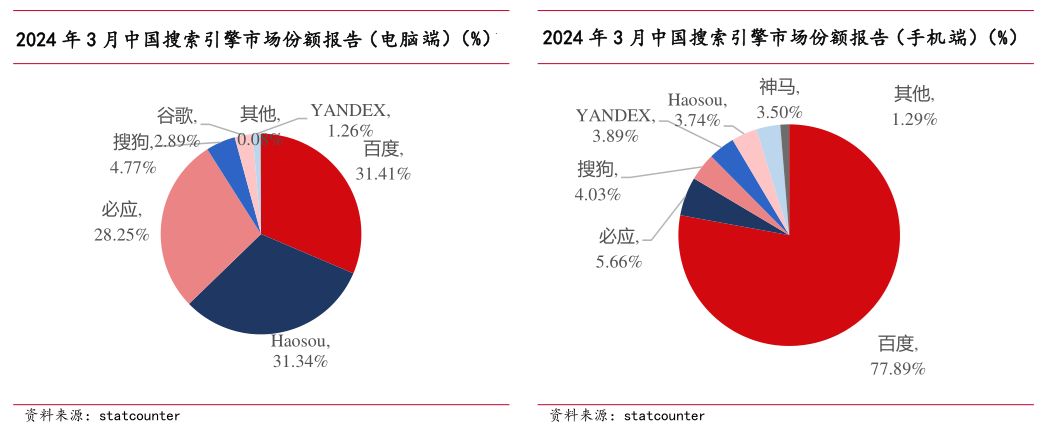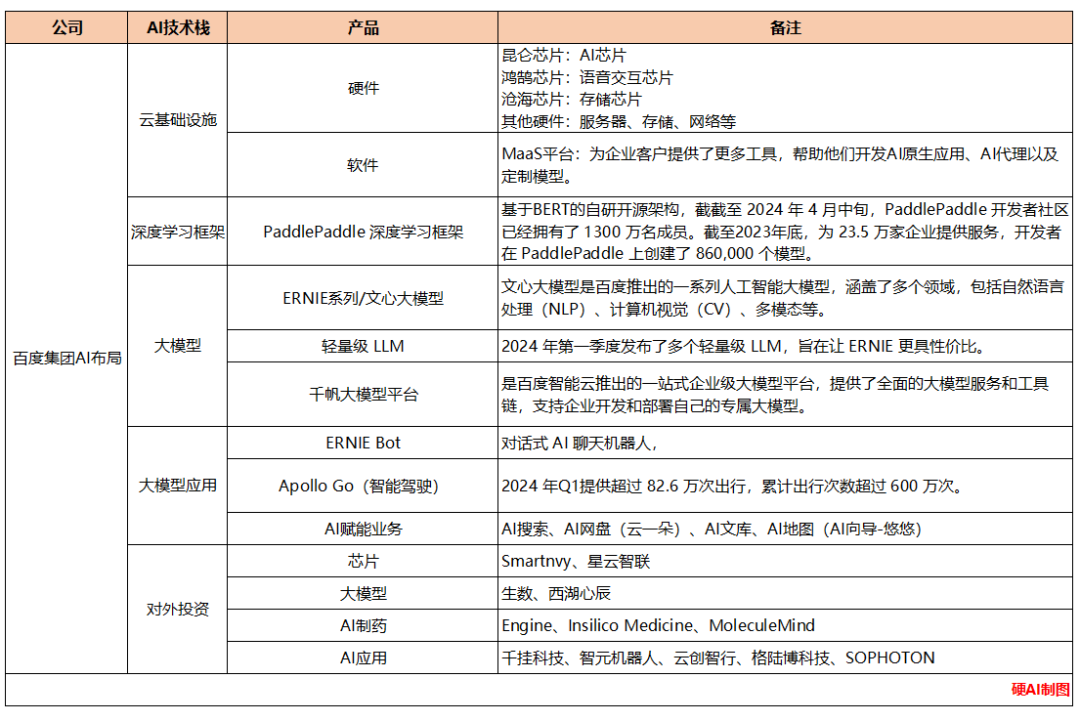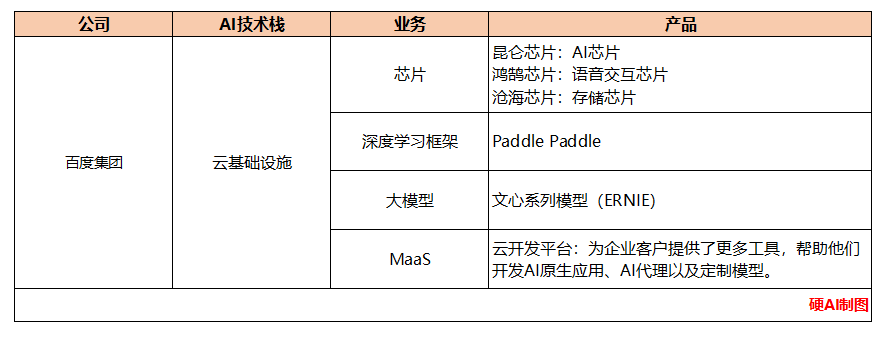Article Source: Hard AI
Author | Zhang Yifan
Editor | Hard AI

Image Source: Generated by Unlimited AI
At the 24Q1 financial report meeting, Baidu Group revealed the latest progress of its AI business.
Baidu, a technology giant that emerged in the PC era, is facing challenges and competition in the mobile internet era. It seems to have not fully seized the opportunities of the era and appears somewhat behind compared to the rapid development of other technology companies at this stage.
As time enters the era of artificial intelligence (AI), Baidu hopes to take this opportunity to make up for the lost ground in the mobile internet era and re-establish its leadership position in the field of technology.
At the recent Baidu's latest financial report meeting, the company revealed the latest progress of its AI business:
- AI cloud service revenue increased by 12% year-on-year;
- 11% of Baidu's search content is generated by AI;
- The API call volume of large models has surged: from 50 million to 200 million in nearly five months;
- Significant optimization of AI model performance: training efficiency improved by 5.1 times, and inference cost reduced to one percent.
Baidu's Chairman and CEO Robin Li said in a conference call that the company is shifting from being internet-centric to AI-centric, promoting the reconstruction of To C and To B businesses with large language models. Currently, the large language model processes approximately 250 billion tokens of text daily and has an average daily call volume of 200 million.
Robin Li emphasized that search is most likely to become the "killer app" of the AI era, and the AI reconstruction work of Baidu search is still in its early stages.
In addition, Baidu's CFO, Robin Li, stated that in the coming quarters, Baidu will continue to support high-quality growth of its AI business. The company believes that as China's generative AI enters a new era, it will bring more opportunities to Baidu.
01
"All in AI" - Baidu's New Opportunity?
To achieve Robin Li's goal of "shifting from being internet-centric to AI-centric," Baidu is heavily investing in the research and application of AI technology, especially in areas such as autonomous driving, deep learning, and natural language processing.
Baidu is trying to regain the ground it lost in the mobile internet era.
- In the PC era, with its unique search engine technology, Baidu became the leader in domestic search;
- In the mobile internet era, as user traffic shifted from the PC end to the mobile end, the company, despite its multi-faceted layout, still lagged behind Tencent/Alibaba;
- In the era of recommendation algorithms, it fell far behind the decentralized model of ByteDance;
- Stepping into the AI era, based on its deep accumulation in the field of AI, Baidu hopes to break through in this wave.
The effects of AI are gradually highlighted in the financial report. In the first quarter of this year, the revenue of the intelligent cloud business reached 4.7 billion yuan, a year-on-year increase of 12%, and the revenue from generative artificial intelligence and basic models accounted for 6.9% of the revenue of the intelligent cloud business.


02
AI Cloud Services, From Chips to Platforms
In 2016, Baidu CEO Robin Li proposed the cloud service strategy of "AI + Cloud + Big Data."
Since then, Baidu Intelligent Cloud has built a full-stack AI infrastructure of "chips - frameworks - models - MaaS platforms," which supports the full-chain AI services from data storage to model training, deployment, and operation.

It is worth mentioning that Baidu's PaddlePaddle platform is compatible with more than 50 different chips, many of which are domestically designed, and the developer community has grown to 13 million.
This AI infrastructure layout model also allows Baidu to better match the domestic AI cloud demand in the face of external constraints. Robin Li believes that this model enables Baidu to use less advanced chips for highly effective model training and inference.
Robin Li stated in the conference call that Baidu integrates GPUs from different suppliers into a unified computing cluster for training large language models. "Our platform has demonstrated very high efficiency on the GPU cluster, which consists of hundreds or thousands of GPUs. This is an important breakthrough in the context of restricted imports of GPUs."
1) Self-developed chips
The company has independently developed AI chips (Kunlun) and speech interaction chips (Honghu), used to optimize AI technologies such as speech, natural language processing, and image, and support the company's deep learning framework.
Latest progress of the chips:
- AI chip: iterated to Kunlun 2, with a performance improvement of 2-3 times compared to Kunlun 1, providing 128TFLOPS computing power and 512GB/s memory bandwidth;
- Speech interaction chip: iterated to Honghu 900, with a 200% improvement in CPU performance and a 160% improvement in GPU, deployed on Huawei Smart Screen V5 Pro.
2) Deep learning framework - PaddlePaddle
PaddlePaddle is Baidu's self-developed deep learning framework based on BERT, integrating core training and inference frameworks, basic model libraries, end-to-end development kits, and a rich set of tool components.
The framework serves enterprises in various industries such as energy, finance, industry, healthcare, and agriculture. For example, Lianxin Medical's "AI system for lung pneumonia screening and pre-assessment based on CT images," developed on the PaddlePaddle platform, has been put into use at the Xiangnan Affiliated Hospital of Chenzhou University in Hunan.
PaddlePaddle is open source, making it easier for Baidu to build its own AI ecosystem.
According to the company's disclosure:
- As of mid-April 2024, the PaddlePaddle developer community has grown to 13 million members;
- By the end of 2023, PaddlePaddle served 235,000 enterprises, and the development community had created 860,000 models.
In addition, data shows that PaddlePaddle ranks second only to leading overseas platforms PyTorch and TensorFlow in terms of the number of users, contributors, and technical iteration speed on GitHub.
3) AI large models - Wenxin series models (Ernie)
Based on the powerful basic model (PaddlePaddle), Baidu has developed the Wenxin series model Ernie (fun fact: the English name for Wenxin Yanyan is "Ernie," derived from the character in the American children's program "Sesame Street," and Ernie's good friend in the show is Bert, the AI model released by Google in 2018).
Currently iterated to Wenxin 4.0, the parameter scale may exceed 10 trillion, about 4-5 times that of Wenxin 3.5.
According to the company's disclosure, as of April this year, the Wenxin model processes approximately 200 million API calls per day, far exceeding the approximately 50 million calls in December last year, indicating that Baidu's Wenxin model is being adopted by more and more people, and signaling strong income potential for model inference in the future.
Furthermore, to make the model more cost-effective, the company continuously improves the model's efficiency through its unique four-layer AI architecture and powerful end-to-end optimization capabilities. Compared to the version on March 23, the training efficiency of the Wenxin model has increased by 5.1 times, and the inference cost has been reduced to one percent.
4) MaaS (AI Development Cloud Platform)
In order to make it easier for developers to develop AI models, Baidu provides three sets of tools on its cloud platform:
- AppBuilder and ModelBuilder: for enterprises and individual developers to develop applications and build models;
- AgentBuilder: to easily create an AI agent;
In terms of profitability, starting from 2022, Baidu has focused on improving the profitability of its AI intelligent cloud business, abolishing low-quality businesses, and is committed to customizing standardized AI solutions for clients in different industries.
At the 24Q1 performance meeting, the company stated that the growth in intelligent cloud revenue is mainly driven by generative AI and model training. Currently, most of the revenue comes from model training, but the revenue from model inference is growing rapidly.
Looking ahead, Baidu believes that model inference is one of the most important long-term opportunities and a major driver of future AI cloud revenue growth.
03
"AI+" Business Empowerment
AI technology is widely used within Baidu in multiple areas such as search engines, information flow recommendations, and Baidu Translate.
During the conference call, Robin Li expressed more confidence in the future AI-empowered search pillar business, believing that search is the product most likely to become a killer app in the AI era: "AI search enables users to do things they couldn't do before, and Baidu currently has no plans to charge for this."
Since the second quarter of last year, Baidu has been using Wenxin Yanyan to rebuild Baidu search, and now more and more search results are composed of Wenxin Yanyan in different formats such as text, images, third-party links, etc.
In model construction, Baidu uses three lightweight models and two task-specific models, combined with expert hybrid models, to allocate tasks to large models and find a better balance between performance and cost.
From a data perspective, AI is indeed improving the efficiency of various Baidu businesses:
1) AI + Baidu Search: As of 24Q1, 11% of Baidu search content is generated by AI, and AI search has driven the growth of advertising revenue; 2) AI + Baidu Wenku: By introducing generative AI features, it has attracted 18% of new paying users. These features include content summarization, creation, expansion, and one-click transformation of inspiration into PowerPoint, etc. The number of paying users for Baidu Wenku achieved double-digit year-on-year growth in 24Q1. 3) AI + Baidu Maps: Introduced the "AI Guide" feature, which, based on understanding user needs, intelligently calls upon various map functions and services to provide quick and accurate solutions; 4) AI + Baidu Wangpan: Launched the intelligent assistant "Cloud Yiduo" based on the Wenxin large model, which helps users quickly search for files and videos, summarize knowledge, translate documents, and even create content with a single sentence. As of 23Q3, the number of "Cloud Yiduo" users has reached 20 million.
04
Cooperation with Terminal Manufacturers - AI Phones/AI PCs
In addition to improving internal efficiency, this quarter Baidu has further expanded its external cooperation.
According to the company's disclosure, in the last quarter, the company had already reached cooperation with smartphone manufacturers such as Samsung China and Honor. This quarter, the cooperation has expanded to more leading smartphone manufacturers, including Oppo, VIVO, and Xiaomi.
The business scope has also expanded from smartphones to the PC and electric vehicle fields, further expanding Baidu's AI ecosystem. Lenovo is using the Ernie API to support its AI assistant in the default browser, and NIO has started using the Ernie API to enhance the in-car experience.
In addition, the company has attracted many new customers, including Ctrip, Gaotu, Zhaopin, Homework Help, and the Singapore Tourism Board, helping them to reconstruct all consumer-facing products using AI technology to provide a better user experience.
05
External Investments
In addition to independent research and development, Baidu also continuously expands its own AI ecosystem through external investments, covering the three major aspects of chips, models, and model applications. However, it is clear that, unlike Alibaba, Baidu's external investments tend to focus on the upper and lower ends.
This is not difficult to understand, as Baidu will rely on applications such as search to support its income in the future and complete the commercial model loop.
A representative proof of this comes from Robin Li's judgment on whether large models should be open source or closed source: "There is little significance in open sourcing large models. Closed source can make the commercial model work, make money, gather computing power, and gather talent."
"Closed source actually has advantages in terms of cost. As long as the capabilities are equal, the inference cost of closed source models will definitely be lower, and the response speed will definitely be faster." This is also a different business model consideration from Alibaba Cloud.
So, according to Baidu's thinking, the future path is already quite clear, but the competition in the AI era will obviously be more intense than in the PC era.
免责声明:本文章仅代表作者个人观点,不代表本平台的立场和观点。本文章仅供信息分享,不构成对任何人的任何投资建议。用户与作者之间的任何争议,与本平台无关。如网页中刊载的文章或图片涉及侵权,请提供相关的权利证明和身份证明发送邮件到support@aicoin.com,本平台相关工作人员将会进行核查。




